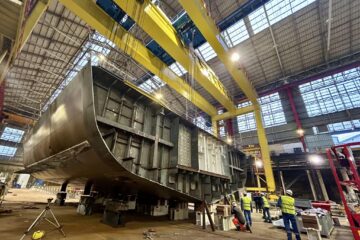This will be the first major refit (known in the U.S. Navy as “docking continuous maintenance availability”) for Le Terrible and will involve 14 months of industrial activities to modernize the boat and restore its operational potential for the next 10 years.
The submarine’s refit work began on the operational base of l’Ile Longue with two major operations: the unloading of the weapons and the removal of the fuel elements from the nuclear reactor. The SSBN will now undergo major maintenance and upgrade works in dock 8 at the Brest naval base.
As the project’s prime contractor, local shipbuilder Naval Group has been in charge of the program since early November 2020. The French Navy’s Fleet Support Service has ownership and is responsible for maintaining the fleet in operational condition.
The main works to be carried out are maintenance of the hull and its structures, energy and propulsion, diving safety, the platform control and operation systems, utilities associated with life onboard, detection and fight against threats and the deterrent weapon system. In addition, 300 modifications will be made to various installations in order to improve the SSBN’s control and performances.
The refit and upgrade work will last for around 14 months after which the submarine is set to return to its operational base to reload the reactor core, start up the installations and carry out sea trials before returning to its operational cycle.
About the Triomphant-class SSBN

The Le Triomphant-class is a class of four nuclear-powered ballistic missile submarines (SSBN) of the French Navy built by DCNS (now known as Naval group). They are known in French as Sous-Marin Nucléaire Lanceur d’Engins de Nouvelle Génération – SNLE NG. They replaced the Le Redoutable-class from 1997. They were commissioned in 1997, 1999, 2004 and 2010.
These submarines are fitted with 16 submarine-launched ballistic missile launching tubes each and are equipped with M51 ballistic missiles but also traditional armament such as torpedoes and anti-ship missiles, Exocet. Le Terrible, last ship of the class which was commissioned in 2010, was fitted with M51 capability from its construction. The other three SSBNs originally deployed M45 missiles and were upgraded for the new M51 missile by DCNS
Triomphant-class SSBNs are dedicated to the French nuclear deterrent mission. As such, at least one of the SSBN is always deployed at sea. The fleet of 4 SSBNs ensures that 3 can be maintained in the operational cycle and continuously guarantee there is at least one SSBN at sea during peacetime.
Le Triomphant-class main specifications:
Displacement: 12 640 tonnes surfaced; 14 200 tonnes submerged
Length: 138 m
Beam: 12.5 m
Depth: <300 m
Propulsion: nuclear reactor K15, turboreductor system, two diesel-powered generators SEMT Pielstick auxiliaries
Nuclear weapons: 16 ballistic missiles M51
Traditional weapons: four 533 mm torpedo tubes for F17 torpedoes and Exocet SM39 anti-ship missiles
Crew : 110
About M51 SLBM

The M51 is the new generation intercontinental SLBM which started replacing the M45 in 2010. Each missile carries six to ten independently targetable (MIRV or Multiple Independently targeted Reentry Vehicle) TN 75 thermonuclear warheads. TN 75 are being replaced with the new Tête nucléaire océanique (TNO or oceanic nuclear warhead) warheads since 2015. These new warheads are reported to be maneuverable (MARV or Maneuverable Re-entry Vehicle) in order to avoid potential ballistic defenses. The TNO has a yield that is estimated to be greater than or equal to the yield of the TN 75 warhead, 150 kilotons of TNT (kt) with a CEP (circular error probability) of 150 meters.

The three-stage engine of the M51 is directly derived from the solid propellant boosters of the European Ariane 5 space rocket. Open source data indicates an M51 weight of 52,000 kg, a length of 12.0 m and a diameter of 2.3 m. M51 operational range is reported to be 8,000 to 10,000 km with a speed of Mach 25.
The first test launch of an M51 ballistic missile was successfully carried out at Centre d’essais de lancement de missiles (CELM) in Biscarosse, France, on November 9, 2006. The sixth missile test carried out on May 5, 2013, ended in failure. Follow on M51 tests took place in September 2015, July 2016 and June 2020 were all successful.






